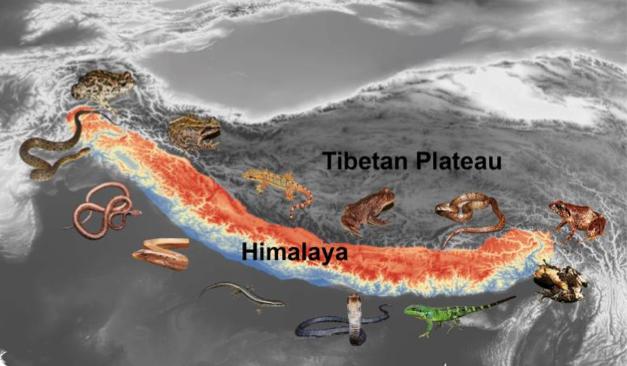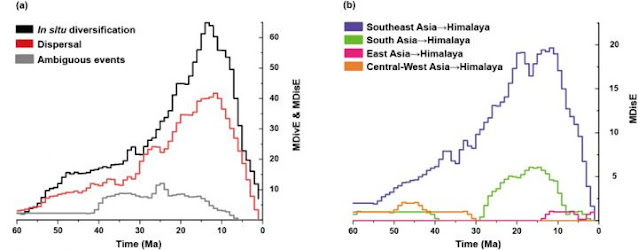The Himalaya are among the youngest and highest mountains in the world, but the exact timing of their uplift and origins of their biodiversity are still in debate. Generally, there are two hypotheses about the uplift process of the Himalaya. The "Stepwise Hypothesis" states that the Himalaya rose slowly from 1000-2500 m during 56-23 million years ago (Ma), before an additional rapid uplift to 4000 m during 23-19 Ma, and a final rise to the current average elevations (~5000 m) at around 15 Ma. Alternatively, recent hydrological and thermal evidences support that this region was probably not elevated to current elevation till mid-Pliocene ("Late Orogeny Hypothesis").
 |
| The Himalaya and representative amphibians and reptiles [Credit: Science China Press] |
Time-based records of biological processes can be informative about montane histories and environmental changes. Various hypotheses about Himalayan origins can be tested using phylogenetic information and estimates of the timing of biological speciation events. To address the question about the timing of the Himalaya uplift, we carried out field work across the Himalaya to collect samples of amphibians and reptiles. The Himalayan region encompasses multiple countries and has many access challenges, so sampling across the entire region is difficult, which has inhibited integrative studies of the origin of the Himalayan biota.
Combining 14 time-calibrated phylogenies of Himalayan-associated amphibian and reptile families involving 85 genera and 1628 species, we estimated times of divergence among 183 species that occur in the Himalaya. We identified 230 biogeographic events related to the Himalayan species. The dynamics of in situ diversification and dispersal rates remained essentially parallel across the Cenozoic. Both the in situ diversification rate, as well as the dispersal rate into the Himalaya, fit the Stepwise Hypothesis for the origin of this mountain range. In contrast, our estimates of origination and peak diversification are not consistent with the late-uplift hypothesis.
The rapid Himalayan uplift and associated intensified South Asia Monsoon not only promoted a pulse of uplift-driven in situ diversification, but also affected the rates of biotic interchange. Biotic interchange was restricted by the lack of a moist environment that is required by many reptiles and amphibians. In contrast, an expanded tropical forest belt is thought to have persisted between the Himalaya and Southeast Asia since the middle Miocene, which likely accounts for the high dispersal rates between these two regions.
This work has important implications about the assembly process of Himalayan herpetofauna and its conservation. Our analyses show a deep-rooted origin of Himalayan herpetofauna originating in the Paleocene, but with rapid diversification in the Miocene.
The study is published in the National Science Review 2020.
Source: South China Press [October 26, 2020]

No comments:
Post a Comment